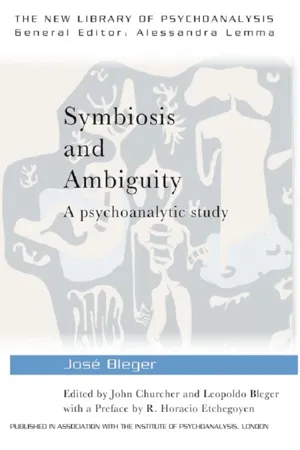
Symbiosis and Ambiguity
A Psychoanalytic Study
- 392 pages
- English
- ePUB (mobile friendly)
- Available on iOS & Android
Symbiosis and Ambiguity
A Psychoanalytic Study
About this book
Symbiosis and Ambiguity is the first English edition of the classic study of early object relations by influential Argentinian psychoanalyst José Bleger (1922-1972). It is rooted in Kleinian thinking and rich in clinical material.
Bleger's thesis is that starting from primitive undifferentiation, prior to the paranoid-schizoid position described by Klein, autism and symbiosis co-exist as narcissistic relations in a syncretic 'agglutinated' nucleus. In symbiosis part of the mind is deposited in an external person or situation; in autism it is deposited in the patient's own mind or body. The nucleus is ambiguous and persists in adults as the psychotic part of the personality.
Symbiosis tends to immobilise the analytic process, so the analyst must mobilise, fragment and discriminate the agglutinated nucleus, whose ambiguity tends to 'blunt' persecutory situations. The psychoanalytic setting functions as a silent refuge for the psychotic part of the personality, where it creates a 'phantom world'. At some point, therefore, the setting itself has to be analysed and the analytic relationship de-symbiotised, as Bleger observes in a celebrated chapter on the setting.
José Bleger's work demonstrates the need to analyse early narcissistic object relations as they arise clinically, especially in the setting. More widely, he regards undifferentiation and participation as operating throughout life: in groups, institutions, and society as a whole.
Frequently asked questions
- Essential is ideal for learners and professionals who enjoy exploring a wide range of subjects. Access the Essential Library with 800,000+ trusted titles and best-sellers across business, personal growth, and the humanities. Includes unlimited reading time and Standard Read Aloud voice.
- Complete: Perfect for advanced learners and researchers needing full, unrestricted access. Unlock 1.4M+ books across hundreds of subjects, including academic and specialized titles. The Complete Plan also includes advanced features like Premium Read Aloud and Research Assistant.
Please note we cannot support devices running on iOS 13 and Android 7 or earlier. Learn more about using the app.
Information
Table of contents
- Cover Page
- Half Title page
- Series Page
- Title Page
- Copyright Page
- Contents
- Preface
- Editorial Introduction
- Acknowledgements
- Symbiosis and Ambiguity
- Part One: On Symbiosis
- Part One: On Ambiguity
- Part Three: Appendix
- References
- Index